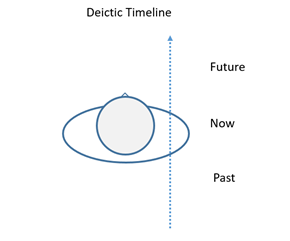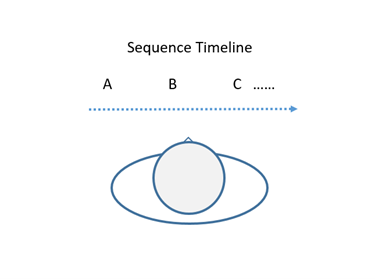In linguistics, tense is a grammatical category that locate situations in time (Fabricius-Hansen, 2006). Some spoken languages e.g., European languages like English, German and Spanish, have elaborate verbal morphological systems to differentiate past, present, and future tenses. In English, tense can be expressed by morphological markers on verbs (e.g., play-s vs. play-ed, go vs. went) or auxiliary words (e.g., has played, had played, will play)(Example 1a & 1b). Some languages do not have grammatical tense, e.g., Chinese, Vietnamese, Indonesian. In these languages, the temporal ordering of events is mainly expressed by temporal adverbials (e.g., yesterday, last week, tomorrow) without any inflection markings on the verbs (Example 2a & 2b).
Example (1a) He played basketball yesterday. (English)
Example (1b) He will play basketball tomorrow. (English)
Example (2a)
| 他 | 昨天 | 打 | 籃球 |
| ta | zuotian | da | lanqiu |
| he | yesterday | hit/play | basketball |
Example (2b)
| 他 | 明天 | 打 | 籃球 |
| ta | mingtian | da | lanqiu |
| he | tomorrow | hit/play | basketball |
Previous studies suggest that verbs in sign languages do not inflect for tense in the way they do in European languages (Schermer & Koolhof, 1990; Wilbur, 1979; Leeson, 1996). Hence, sign languages can be categorized with other ‘tenseless’ languages such as Chinese (Binnick, 1991). Similar to other sign languages, HKSL does not have tense markings on verbs. Whether the event is past, present, or future is determined by the temporal adverbials or contexts (3a and 3b). In (3a), the time frames of two sentences are set by YESTERDAY and TODAY respectively. In (3b), the adverb ALWAYS and TOMORROW suggest that the first clause is about the present situation – the person is habitually late.
Example (3a)
YESTERDAY HEAVY-RAIN TODAY MORNING RAIN-STOP SUN-SHINING
‘It rained heavily yesterday. This morning the rain stopped and the sun shone brightly.’
Example (3b)
IX[=he] LATE ALWAYS, TOMORROW LATE CERTAIN
‘He is always late. He will be late tomorrow, for sure.’
Although sign languages in general do not have tense markings on verbs, it is actually quite common for sign languages to mark time spatially through ‘timelines’. In such timelines, specific times are localized in space, and the procession of time can be represented metaphorically by movements among the locations (Engberg-Pederson, 1992; Winston, 1995; Arik, 2012). Some of these timelines are illustrated by Hong Kong Sign Language below.
Deictic Timeline (front/back):
The deictic timeline is an abstract line that extends from behind the signer’s dominant-hand shoulder to the space in front of it, with the signer’s location as the reference point for the utterance time (i.e., the present time/now)

As the reference point, the location of the signer divides the line into three parts: ‘before now/past’ (behind the reference point), ‘now’ (reference point), and ‘after now/future’ (in front of the reference point) (Engberg-Pederson, 1992). This timeline can be reflected in the articulatory characteristics of some temporal adverbials in HKSL, e.g., A-LONG-TIME-AGO, PAST, NOW, TODAY, FUTURE, DISTANT-FUTURE.
A-LONG-TIME-AGO, PAST, NOW, TODAY, FUTURE, DISTANT-FUTURE
Sequence Timeline (left/right)
The sequence timeline is an abstract line in parallel with the signer’s surface plane, which extends from the signer’s left to right. For a right-handed signer, the sequence line runs from left to right. This means that, if locus A is located left to locus B, A would stand for a time earlier than B (Engberg-Pederson, 1992).

The sequence timeline can be manifested in signs such as NEXT and ONE-AFTER-ANTOHER. It may also be invoked when a signer wants to describe a sequence of acts, as in the following HKSL example (Example 4):
Example (4):
IX[=me] MORNING BUSY ALWAYS, FIRST COOKa FINISH, CLEAN-UP-PLACEb FINISH, IN-ADDITION CLOTHESc WASHc , REALLY HARD
‘I am always very busy in the morning. First I cook, then clean up my home, and then wash the clothes. This is really tiring.’
Calendar Timeline (left/right, vertical)
The calendar plane is a two-dimensional plane in parallel with the surface plane of the signer’s body. This plane looks like a calendar with columns that stand for days of the week, and rows that stand for weeks of the month. With this plane, the progression of time proceeds from the left to right (e.g., if the time change is related to the days of the week), or proceeds vertically from a higher locus to a lower one. In HKSL, the calendar plane is manifested in signs related to days of the week (Examples 5 & 6):
Example (5)
NOW (this) WEEK IX[=me] WORK TUESDAY, THURSDAY
‘This week I work on Tuesday and Thursday.’
Example (6)
IX[=me] WORK MONDAY-TO-FRIDAY-OVER-A-LONG-PERIOD-OF-TIME (with a downward movement)
‘I work from Monday to Friday, and this work pattern continues for many weeks.’
The vertical, downward progression of time is also manifested in adverbials such as ALWAYS and NEVER, or lexical signs such as TRADITION. The above examples illustrate how temporal relations can be metaphorically expressed through the use of space, and such timelines have been observed in quite a lot of sign languages studied to date.
Reference:
- Arik, E. (2012). Space, time, and iconicity in Turkish Sign Language (TID). Trames journal of the humanities and social science, 16 (4), 345-358.
- Binnick, R. I. (1991). Time and the verb: A guide to tense an aspect. Oxford University Press.
- Brentari, D. (1998). A prosodic model of sign language phonology. Mit Press.
- Catherine, F. H. (2006). Tense. In E.K. Brown, A. Anderson (Eds.). Encyclopedia of language and linguistics (2nd ed.) (pp. 566-573). Elsevier.
- Leeson, L. M. (1996). The expression of time in sign languages with special reference to Irish Sign Language. [Master’s thesis, University of Dublin].
- Nilsson, A. L. (2016). Embodying metaphors: Signed language interpreters at work. Cognitive Linguistics, 27(1), 35-65.
- Schermer, T., & Koolhof, C. (1990). The reality of time-lines: Aspects of tense in Sign Language of the Netherlands (SLN). In S. Prillwitz, & T. Vollhaber (Eds.), Current trends in European sign language research (pp. 295-305). Signum.
- Wilbur, R. B. (1979). American Sign Language and sign systems. University Park Press.
- Winston, E. (1995). Spatial mapping in comparative discourse frames. In K. Emmorey, & J. S. Reilly (Eds.), Language, gesture and space (pp. 87-114). Lawrence Erlbaum Associates.
![]()
